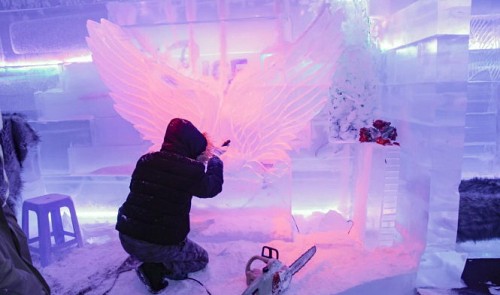Craftsmen in Ho Chi Minh City have been putting in hours of physical effort in freezing temperatures to create fantastic yet short-lived ice sculptures, which have been in rising demand in recent years.
Thanks to the dexterity of the artisans, rough blocks of ice are sculpted into intricate, transparent sculptures of all shapes and sizes.
Multicolored lights are also used to give character to the ice, creating a spectacle when lit up at night.
Recently, Le Ho Quang Vinh, 30, an ice sculptor residing in District 8, Ho Chi Minh City, was making crude cuts on a 1m-long ice block in a large freezer-like workshop.
He then used a chainsaw to carve the ice into blocks, with multiple rays of light emitted in the process.
After a while, when the sculptures began to take shape, Vinh worked on the details with chisels and grinders.
Finishing touches were then applied.
This technically-demanding craft is done by veteran artisans who understand the techniques like the back of their hand.
It requires great creativity and an acute sense of esthetics to design and craft such exquisite items.
As no institutions in Vietnam offer training in ice sculpture, most ice sculptors have switched to the craft from other jobs.
“I worked at a mechanics tool firm previously, but my family, who run an ice making business, wanted me to take up ice sculpture. I’ve been infatuated with the art ever since,” Vinh shared.
However, several have succumbed to the unforgiving, taxing nature of the work and quit.
Vinh recalled the immense difficulties he faced when he first dabbled in ice sculpture four years ago.
“I would struggle to carry ice blocks almost three times my weight. My hands went numb and my teeth kept clenching,” he recalled.
Unable to cope with the freezing cold, Vinh dashed out of the room to shake off his shivers every hour.
“My fingers would clamp, and I constantly got bruises on my feet from falling ice,” he added.
“I’m a lot tougher now and can withstand the cold for four hours at a time.”
Recently there has been a growing taste for ice sculptures of various sizes and shapes, used as highlights of wedding receptions, birthday parties and other events.
A pair of swan-shaped ice sculptures, which are one of the most popular designs, fetch approximately VND3.5 million (US$153).
Seasoned artisans can typically complete two to three swans, each of which takes around 45 minutes to finish, during a shift, or eight pieces at most per day if they are willing to brave the biting cold.
Ice sculptors are literally burning themselves out to cater to the surge in demand towards year end, when weddings and other events peak. “By the end of the year when I work to full capacity, my arms and shoulders are tired as the tools are heavy and shake fiercely,” Vinh said.
Most ice sculptors are men who can persist in such trying working conditions and take delight in their chosen career which indulges their creative passion.
The most technically demanding client orders are ice portraits of their idols or relatives.
Unlike artists who generally portray human models, ice sculptors rely only on their rich imagination and dexterity to visualize characters and sketch three-dimensional models before actually working on the portraits.
Thach So Thonh, 28, who has been on the job for nearly five years, disclosed new designs, particularly challenging portraits, take him from one day to up to a week to finish.
Vinh revealed that he had recently crafted a two-meter high King Kong gorilla for a local café.
For such a large piece, it took Vinh and his team members more than a week to finish. They had to stack blocks of ice on top of one another and glue them with water adeptly without revealing the joints.
“Portraits require great workmanship in depicting characters’ facial features in a lifelike way. Artisans need to work with their whole heart,” Thonh noted.
A wrong cut or chisel stroke may destroy the whole piece, he added.
Unlike their colleagues who work on enduring materials, ice sculptors have to be fast, and cannot stop halfway once they have embarked on a piece.
“Ice must reach a certain level of transparency to be sculpted, so we use water free of impurities which goes through the same stringent process as that of water used for cooking purposes,” Nguyen Cao Thang, who runs an ice sculpture business, revealed.
The water is then left to freeze for four days on end to form the type of ice they use.
Great care is also taken when shipping the finished pieces to customers.
“Items are wrapped in thermo-proof sheets during shipment. Things get even tougher with clients who live far away as the ice works are transported in freezing trucks,” Thang said.
The sculptors themselves will sometimes sit in the trucks to the event in order to fine-tune the intricately designed works whose details may be eroded during transport.
Despite all the effort, the works will always soon melt and vanish altogether if not stored in the right conditions.
Perhaps it is the temporary nature of ice sculptures that adds to their allure.






















































